ColectivoMultipolar : Documenting Our Life
I first saw ColectivoMultipolar on the dance floor where they were photographing Rosebud, a queer party at Berlin in the Boystown neighborhood. The photographer came over to me and said, “Can…
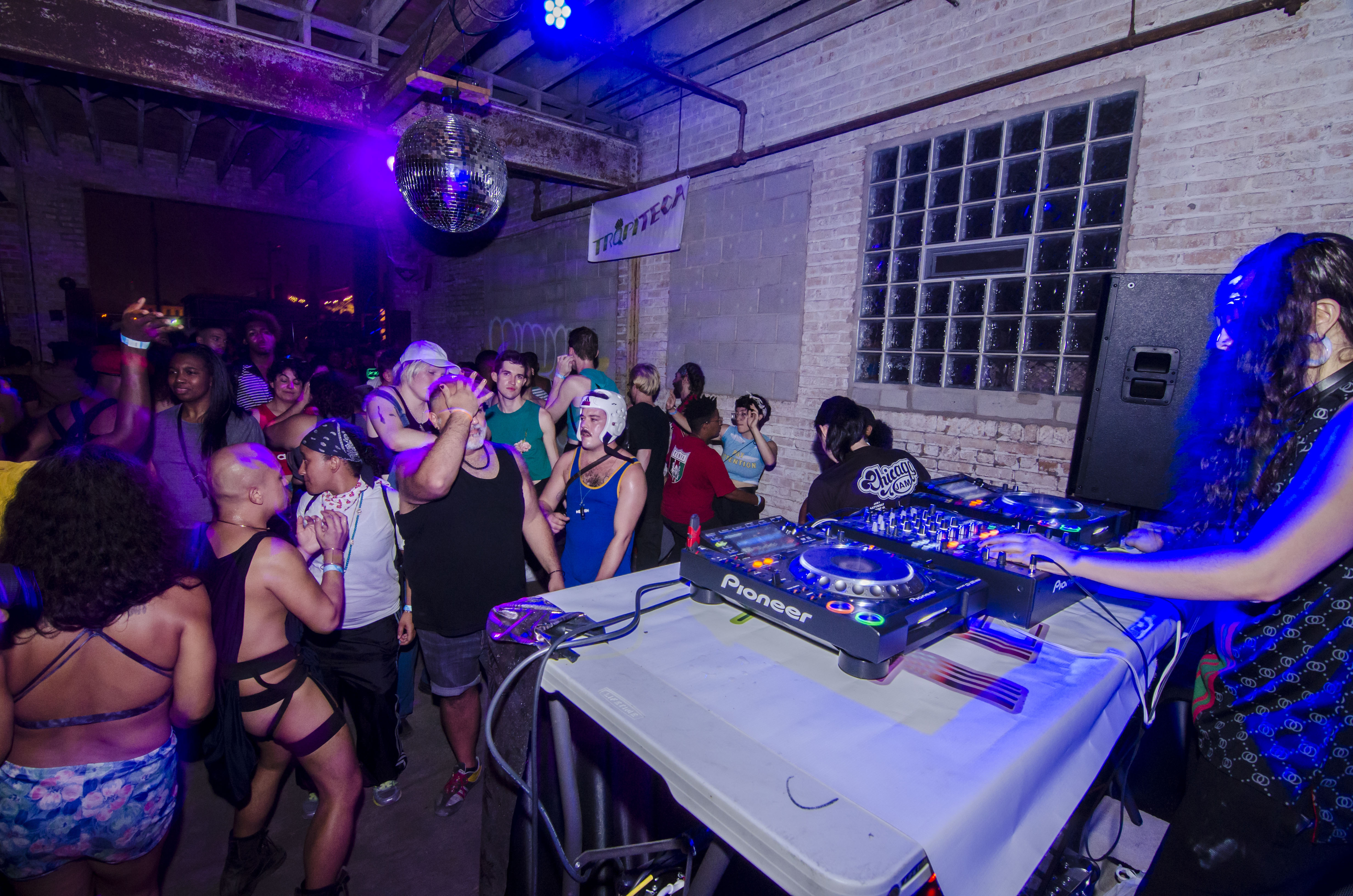
I first saw ColectivoMultipolar on the dance floor where they were photographing Rosebud, a queer party at Berlin in the Boystown neighborhood. The photographer came over to me and said, “Can I take your photo?” to which I smiled and held the hand of a close friend standing nearby. Later on, we would connect again through social media, where I started to follow their practice, follow their friendships, and admire their dedication to the Chicago queer nightlife scene.
The photographer documents party’s all over the city: Daphne, TRQPITECA, Femmes Room, Ariel’s Party. Moreover, ColectivoMulitpolar brings their camera along into the city and on to the dance floor wherever they go, and agreed to meet for an interview.
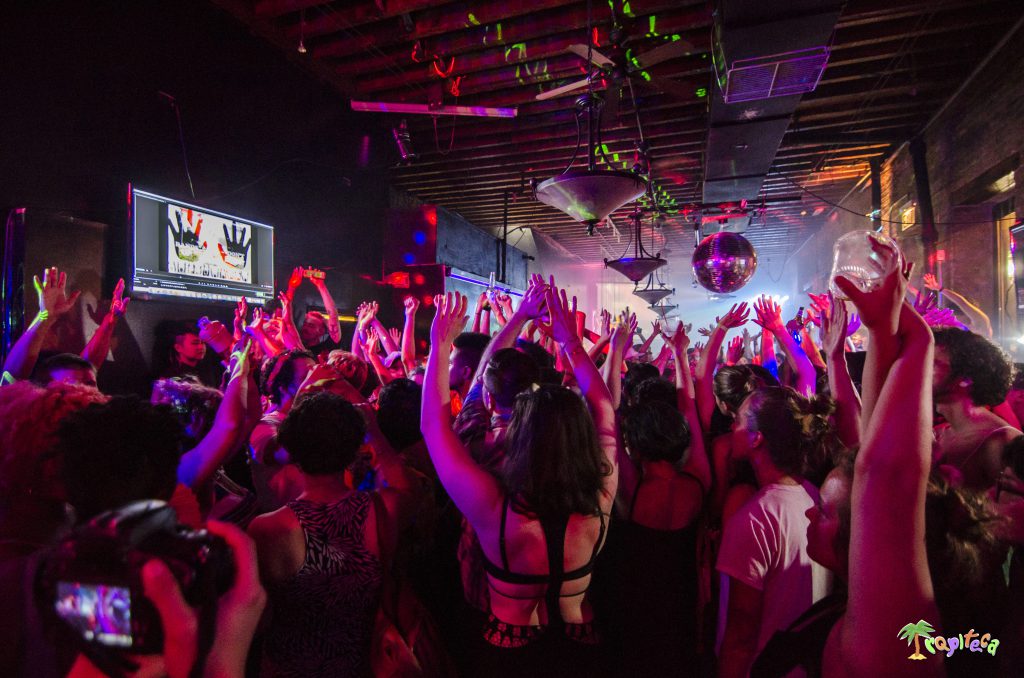
A packed club with a crowd of raised hands and bodies face the stage under pink lights and a disco ball. TRQPITECA, featuring a performance by artist Liz Mputu at Juniors, Pilsen, July 2016. Photo by ColectivoMultipolar.
S. Nicole Lane: Where are you from and how did you end up in Chicago?
ColectivoMultipolar: Soy Mexicana, and there are many stories about how I ended up in Chicago—let’s talk about the happy one. I am the youngest of my five siblings. My mother was very strict with my only sister (10 years my senior), so with me I guess she was tired. Do not get me wrong, I love my mother, she is one of my biggest inspirations, she was always working and making things happen in order for us to have an education, happiness and love. She was the one who taught me that hard work and dedication create opportunities. But perhaps after a difficult marriage and raising four children, my mother had tired a bit. So, basically my sister, my two younger brothers, and my abuelita raised me. This allowed me to be out and about at a very young age.
Fast forward to my last year of high school, a lot of important events happened: I was accepted to my home state university, but I wasn’t ready for that commitment so I said no to school. I came out as lesbian (at the time I wasn’t familiar with Queer as an identity, that came later). I booked my first flight and flew to Chicago. The first time seeing the Chicago Skyline — it’s such a vivid memory to this day. The light and sea of skyscrapers was so amazing! I quickly fell in love with Chicago (my sister was here which is also one of the main reasons I chose this city). I attended my first Pride Parade — not that I liked it, but it was new to me — and I bought all the rainbow swag I could, took my first set of ESL classes, and started my second friendship with a photographer. After a year, I went back to my hometown, San Luis Potosi, Mexico, because I was ready to study at the University, or at least I believed so. Since then my relationship with Chicago has been a long one.
SNL: When did you begin taking photographs?
CM: I was in theater classes when I was around eight or nine and my final presentation was coming soon. I remember my mother was always taking photos with her non-professional Minolta and Olympus camera (a gift from her comadre who lived in Chicago), and I thought, “I need a camera,” to take photos of my artists friends in the play. I asked my abuelita if she could buy me one. She bought the one I saw at the grocery store. It was a 110-film camera, made out of plastic, I don’t remember the brand but it wasn’t a Kodak. I was so excited for “24 photos to shoot” so I took the camera and immediately began taking photos of my actors/actresses friends. However, when I developed the film it was a big disappointment, they were terribly underexposed. I still have those photos and the film; they are in a box in my house in Mexico. I don’t recall being as excited taking photos again until years later.
Now fast forward to when I was back in México and during my second semester at the university, I took a photography class and as a gift my sister sent me from Chicago a brand new SLR camera, a Nikon FM10. Since then my relationship with photography got more serious, especially after having a caring mentor, my photography teacher at that time.
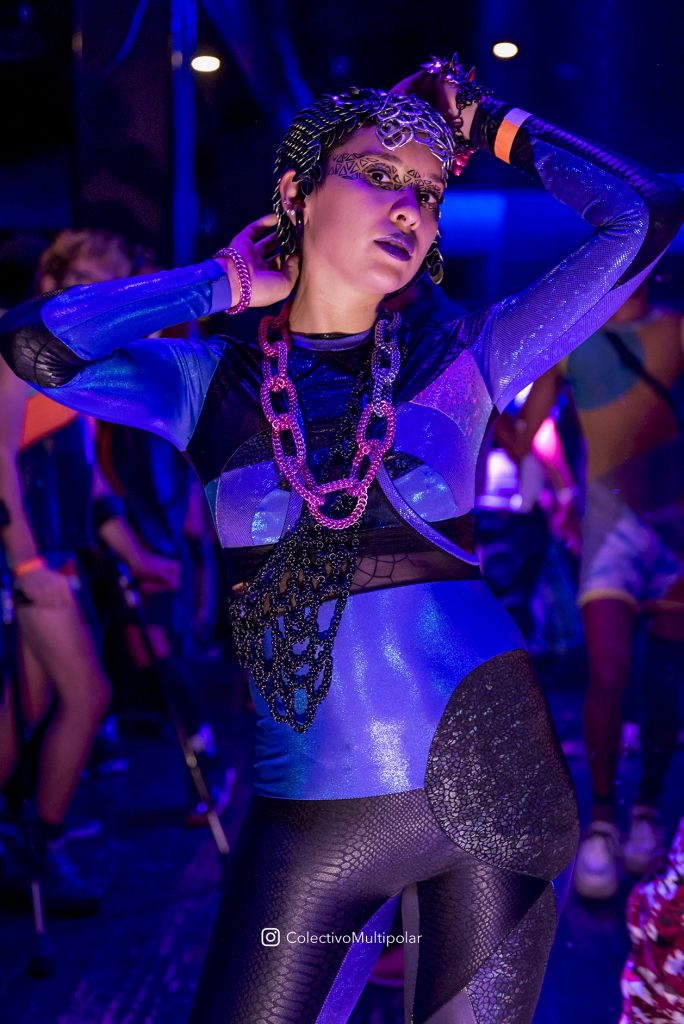
A figure wearing a a blue and black outfit faces the camera with their arms are raised above their head. Artist/Designer Sky Heyn Cubacub (Rebirth Garments) photographed at Rotations, The MID. Photo by ColectivoMultipolar.
SNL: Is the club essential to your identity? Which came first, the club, or the photography?
CM: I love to dance! I love amazing sexy music coming from the best sound system possible (however, some clubs don’t have that great of a sound system). I think that came first, between the club and photography, because I do have other interests. I enjoy clubbing, going to different spaces and meeting new people. I strongly believe that clubs, festivals, and parties have to be about music and diversity, and amazing music could attract amazing people. In the Chicago Queer club scene/community there is a lot of beauty and diversity. I am fortunate to have found a home with some of the most diverse and amazing artists in the city: La Spacer (Dj/producer), Cqqchifruit (Dj/artist), Sofia Moreno (artist), Armando Lozano (artist /photographer), David Nasca (artist), Rosé Hernandez (performance artist), Jonathan Sommer (artist/curator), Amelia De Rudder (artist), and Sky Heyn Cubacub (designer/artist), to name a few.
So, yes, maybe the club is part of my identity but I did not realize it until recently. I have an Instagram where I upload the photos that I took at the club. It is a photo album with memories that bring me happiness and pride. Around a year and half ago I was hired to document more parties at different clubs and spaces.
Getting back to my story about how I end up in Chicago — in the summer of 2016, I began photo documenting the event TRQPITECA in Pilsen, which is “a cultural platform that creates a space for local and international artists working with queer and tropical aesthetics, to experiment, thrive, and celebrate life.” The creators are Natalie Murillo (LaSpacer) and Jacquelyn Carmen Guerrero (Cqqchifruit). But before TRQPITECA, I documented the party ArtSluts by artists Sofia Moreno (A$$ Pus+sy) and Rosé Hernandez (CELESTE) back in 2013, also in Pilsen; and a lot of performance art around Chicago. These experiences allowed me to interact more closely with artists in the queer nightlife in the Southside of Chicago. Photography is part of my identity; the club is a fun place to be and it has to be a safe space. I enjoy the music, lighting design, the sound system, the dance floor, the lqqks, the energy… I want to have my own club. My relationship with photography is very personal — it is a brain exercise, it is a way to keep my memories alive, an affirmation of who I am, and a constant reminder of my/our value and contribution to the community.
SNL: You said earlier that you aren’t so much photographing the club, but rather documenting your life. How often do you shoot photographs?
CM: “Documenting our story” is how I would describe my practice. Our story is about the friendship built through our love for music, art, partying/celebrating, dancing, and sometimes difficulties as queer artists. I shoot maybe three times a week — some paid gigs and others for personal interest. I do not have a studio but I have studio equipment, so I take it to places when I need to. All the gigs I have are in different places: the club, the bar, the gallery, the museum, my friends’ studios, art spaces, the street, etc., and I spend quite a bit of time with basic photo editing. I used to work on more personal ideas using photography but they were really painful pieces. I truly believe it was a therapeutic process to let go of toxic feelings. Documenting our story is an ongoing project that I have been working for the past 10 years, and I am really excited to be able to share it soon.
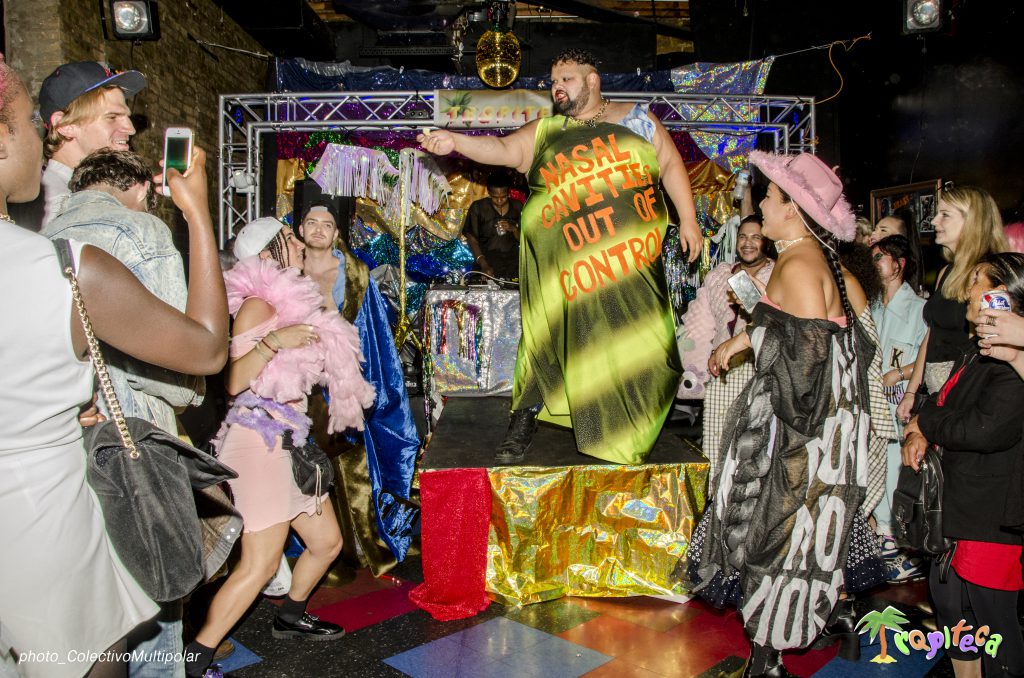
A group of people surround a stage as a performer wearing a green and black outfit holds their hand out to the audience. TRQPITECA’s LQQKS FASHION NIGHT featuring An Authentic Skidmark, designer Kaleigh Moynihan, and performance artist Rosé Hernández, Juniors, Pilsen, October 2016. Photo by ColectivoMultipolar.
SNL: What type of camera do you work with and what is your ideal photography situation/environment?
CM: I use the Nikon D810 and Nikon D7000 with different lenses, and a Lomo’Instant Wide. I work hard, I am a proud immigrant, and I know the value of hard work, and get paid for that. By making money is how I am able to buy new equipment and support myself.
Now regarding the ideal photography situation, as much as I like fog machines at the club, if there are no lasers making a great effect with the fog, I just can’t stand the FOG. My ideal photography situation: thoughtful club lighting, best sound system possible, amazing energy, and cuties everywhere.
SNL: I’ve also seen you mention before that you are a bit shy. How has being a photographer in such a lively environment allowed you to break out socially?
CM: I have been out and about since I was really young — parties, clubs, quinceañeras, weddings, and parties at my house. My family New Years party was a tradition and is now a legend. Everybody was there until January 2nd. Both of my parents love to dance, one of my brothers and my sister-in-law are professional contemporary dancers, my other bothers and sister are good at dancing salsa and cumbia, and I learned from them (not quite as good). I remember going to dancing contests with my oldest brother and sister, hours of dancing, smiles and sweat. So dancing and the club or party environment are part of my memories and present experiences.
You are making me think about how I interact with other people at these spaces. I guess by dancing and connecting through the music. I believe that you can feel the energy from the first time you meet a person, however you can’t trust just anybody. I am a Cancer. In the club scene, it is important to feel that I am welcomed in order to have the confidence to photograph strangers who might have a sort of connection with me because we are both enjoying being at the same space and time in this universe.
How true is the idiom: “A picture is worth a thousand words’? I say this because I care about recognizing beauty and kindness and putting it in an image. So, I will stay shy and express myself through photography.
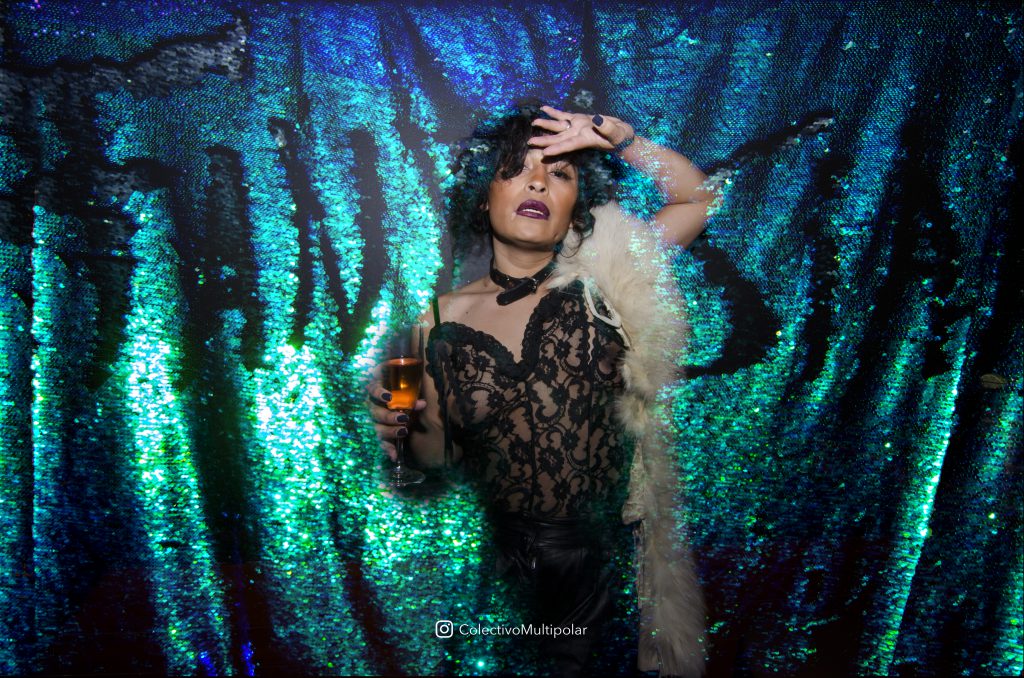
A figure stands in front of a shimmering blue and green sequined background with a drink in one hand while the other hand shields the top part of their face. Artist Sofia Moreno photographed at Fantasia, Pilsen, 2017. Photo by ColectivoMultipolar.
SNL: Do you find photographing people in an intimate dark space challenging?
CM: Yes, of course, technically, but also emotionally because I really care about the particular beauty of the person I am photographing. Nightlife photography could seem annoying for the person enjoying themselves at the club environment, that is one of the reason I try not to over do it because I like to use flash, play with my camera settings, and the lighting available. The club lighting, green lasers, purple, blue, yellow, red, etc., all the colors make me so excited because I can imagine the photo in my mind, I can see how the party people will look with that light available and my personal camera settings. Chicago Queer nightlife photo documentation is so AMAZING; this community is so talented. I am so thankful for being part of this community and being able to witness this moment because I am documenting my/our story. I hope people can see that.
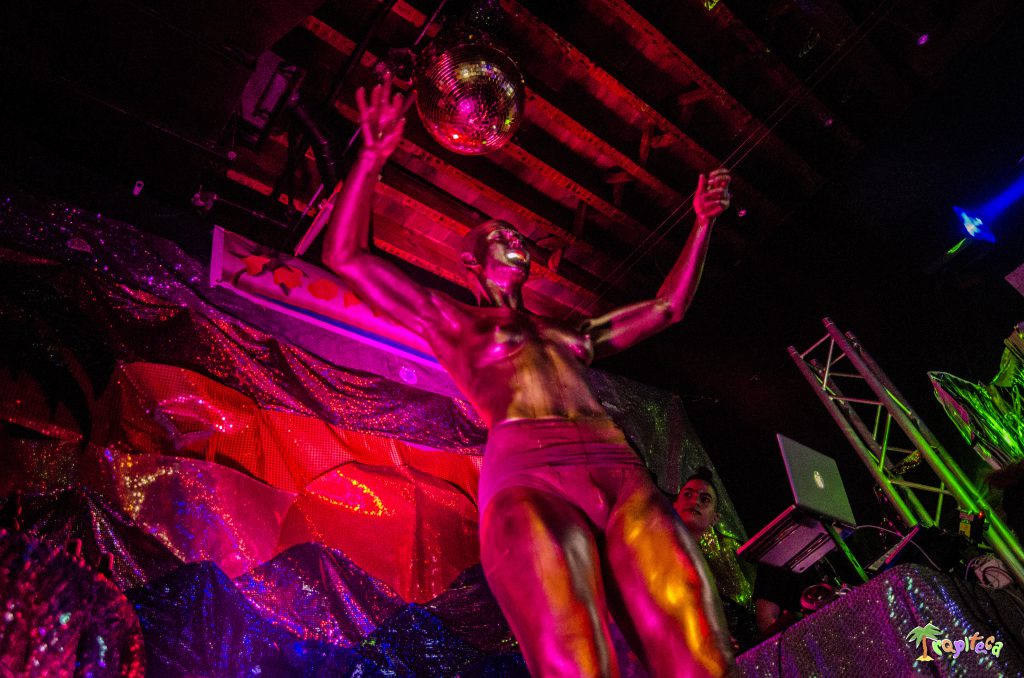
A figure on stage in body paint and under a disco ball and saturated pink/red light above the audience with their hands in the air. TRQPITECA featuring performance artist Boychild at Juniors, Pilsen, July 2016. Photo by ColectivoMultipolar.
On my practice: I do not intend to photograph people drinking, smoking, getting drunk or fucked up. I believe the club is a place to dance, share the energy, have a great time, and look beautiful to the max. I love that energy when you enter a club and the sound system is blasting amazing music, lasers, different light colors, people dancing, talking, making out, wearing local fashion designers garments or their own creations, make-up, no make-up, good energy, and overall having a memorable experience. Sometimes it’s hard to always have all of this but, believe me, I have had that experience and it feels so good.
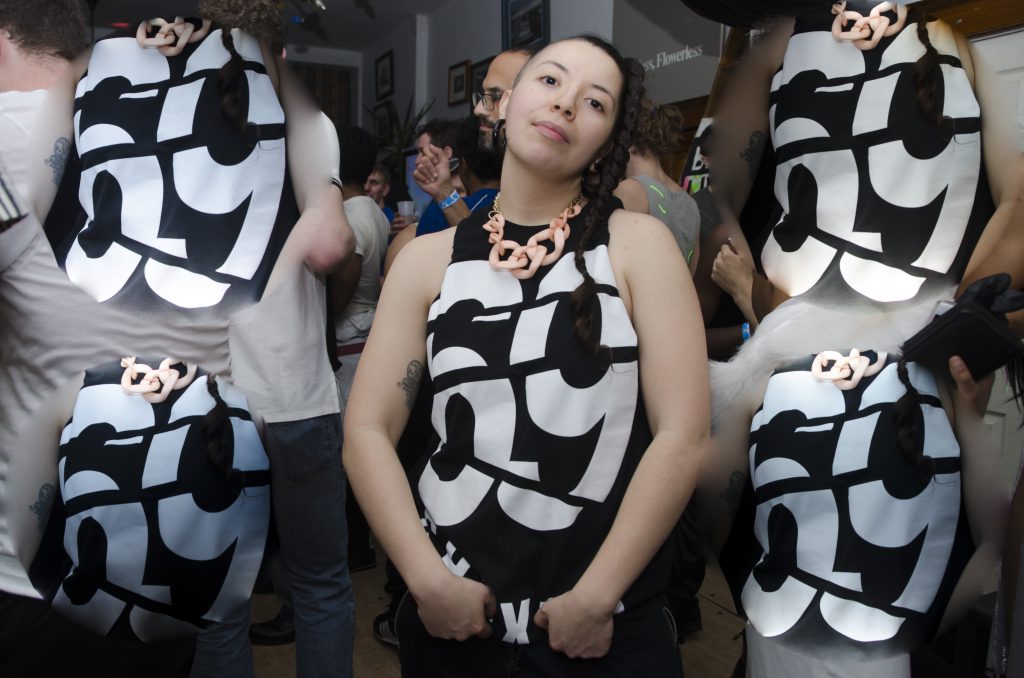
A figure faces the camera with a shirt on that reads “69.” The photographer has edited the photo to have the number “69” repeated on either side of the figure. Dj/producer La Spacer of TRQPITECA photographed in Pilsen, 2017. Photo by ColectivoMultipolar.
SNL: Can you talk about the importance of the queer community for you in Chicago?
CM: I left my house and my country for the first time when I was 17. I wasn’t familiar with the word “queer” until my visit to Chicago. The simple translation of the word “queer” in Spanish is rara/raro (weird). I don’t remember people around me using that word, but I do remember the use of pejorative words towards a lesbian: lencha, machorra, manflora, jota, tortilla, marimacha, rara, and so on. I did not have friends who were openly transgender. I knew a girl who was transsexual. I had couple of gay boys as friends and a few lesbian friends. I was the only open lesbian at the University. Therefore, my experience with a “queer community” did not exist around me. I am not saying that it didn’t exist at all, I just wasn’t part of it or I didn’t know about their existence. Before getting into the University in my hometown, I came to Chicago for the first time, and I wasn’t part of the queer community. It took me a few years coming back and forth to finally find my connection with an unique artistic community in Chicago and it happened to be really queer. I fell in love with all of them, we are still friends since 2008, and we are a community — not just queer — but an artistic queer community/family.
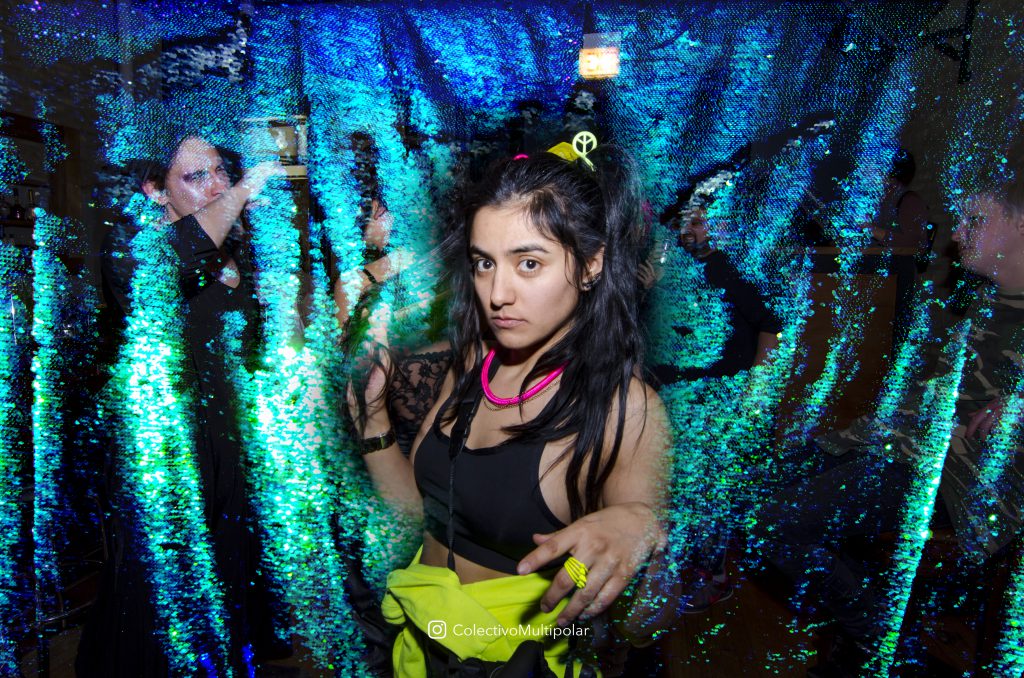
A figure in neon green and a black sports bra faces the camera, standing in front of a shimmering blue and green sequined backdrop. ColectivoMultipolar photographed at Fantasia, Pilsen, 2017. Photo by April Lynn.
I try to be discreet with my personal life, it takes a awhile for me to build a friendship, and I use my Instagram and Facebook to share photos of the work of local, queer, trans, LGBTQ, underground, not underground, amazing artists, friends because I believe in the representation of our community, we need to look after the younger generations and give them something to look at. Yes, it is about the party, but it is more about the bonding, visibility, respect for the other, love, support and to be conscious about our creative potential and capacity to create economic sources to financially support ourselves as artists and/or entrepreneurs.
Featured Image: A Dj spins for a crowd dancing under a disco ball, bathed in blue light. TRQPITECA’s BANG rave with dj/producer La Spacer, September 2017. Photo by ColectivoMultipolar.
 S. Nicole Lane is a visual artist and writer based in the South Side. Her work can be found on Playboy, HelloFlo, Rewire, SELF, and other corners of the internet, where she discusses sexual health, wellness, and the arts. Follow her on Twitter.
S. Nicole Lane is a visual artist and writer based in the South Side. Her work can be found on Playboy, HelloFlo, Rewire, SELF, and other corners of the internet, where she discusses sexual health, wellness, and the arts. Follow her on Twitter.
